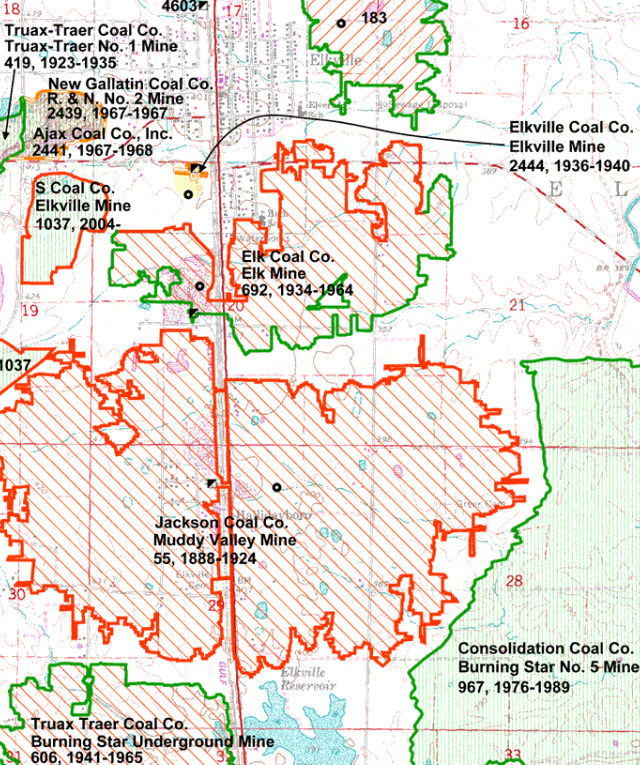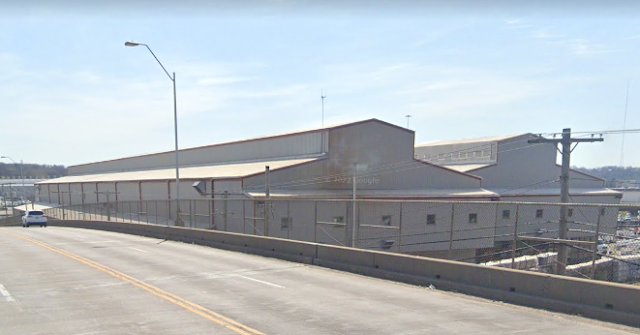Yard: (
Satellite, a lot of the tracks have been removed)
Roundhouse: (
Satellite, they did a good job of removing the foundation.)
PAL = Paducah & Louisville Railroad
I've seen this photo before, but the location was not identified. Now that I know the city and that it still stands, I could find it. And I did not know that coal contained acid that attacked wood and steel towers. That explains why steel towers were rare.
 |
IRM Strahorn Library posted
Illinois Central 2-8-0 number 919 (Alco-Brooks August 1907) posed at the coaling tower in central City, Kentucky after a fresh steam bath on September 28, 1928. The fireman stands on the cab roof after filling the tender with coal while the engineer, having completed his work, waits in the cab. The subject of coaling towers is an interesting one. These massive structures were once common on the railroads, located in virtually all yards and at all maintenance shops. Although some were wood and some steel, those materials were vulnerable to the acids contained in most coal and the material of choice for the largest towers was usually steel-reinforced concrete, which was chemically more stable and longer-lasting. As the diesel era approached, the railroads found that these monsters were hard to shut down. Demolition costs were so high that many were simply left standing and even today, more than sixty years after the end of steam, some still remain. Number 919 had 22x30 inch cylinders, 200 pounds of boiler pressure, 180,000 pounds of weight on her drivers, and produced 39,180 pounds of tractive effort. She was sold in July 1929 to Kaplan Lumber. [Source: Dillon collection 532, Strahorn Library, Illinois Railway Museum] Cliff Downey: Number 919 is long gone, but the Central City coaling tower still stands. And it probably will remain for decades, since it will cost serious $$$ to demolish it.
About 45 miles to the south (by timetable direction), at Dawson Springs , there are two coaling towers along the mainline. When built, there was an enclosed walkway connecting the two towers.
Larry Lavery shared |
 |
Illinois Central Railroad Scrapbook posted
Central City, KY, Oct. 16, 1917. Coal for locomotives normally was loaded into hoppers at the mine, then hauled somewhere, and then dumped into the locomotive's tender. But at some locations the coal came directly from the mine and then was dumped into the tenders. Out of view to the right is a cleaning/crushing/sorting plant for the Madison Coal Company, which was controlled by the IC and supplied the IC with much of its locomotive coal. Most of the coal from the mine was dumped into hoppers for shipment elsewhere, but some of it was carried via an overhead conveyor belt to this wooden tower, where it was dumped into locomotive tenders. IC photo, Cliff Downey coll. |
Illinois Central Railroad Scrapbook posted two photos with the comment:
Central City, Ky., is at roughly the mid-way point on IC's Kentucky Division. The 125.5 miles of track north to Louisville are part of the Louisville District. The 100 miles of track leading south to Paducah are part of the Paducah District.
"King Coal" historically was the major source of freight on the Kentucky Division, and a huge chunk of that coal originated at mines around Central City. During the 1920's IC upgraded its facilities at Central City to handle the growing coal traffic. The line through downtown was elevated and a new passenger station was constructed. A new line between Central City and Dawson Springs was built to tap new coal mines. And a new roundhouse, coaling tower, and freight yard were constructed at Central City.
These two photos were scanned from b&w negatives, taken just moments apart by an unknown photographer. The negatives were in an envelope simply marked "1950". Nine steamers can be seen in the 12 stall roundhouse - six 2-8-2 "Mikados", two 4-6-2's rebuilt for freight service, and (in the far left stall) what appears to be a 2800-class 2-10-2, but the number on the tender is obscured. 2-10-2 2812 is on one of the "whisker" tracks outside the roundhouse to the right, and it is obscuring at least one other steam locomotive on adjacent tracks. 2-10-2 2738 and 2-8-4 8048 are also outside the roundhouse, along with a 1400-series 2-8-2 whose number on the tender is obscured. Another steam locomotive is obscured from view by 8048. Over by the coaling tower, there is another 2-8-2 and what appears to be a 2700-series 2-10-2. At least 3 steam locomotives can be seen off in the distance in the freight yard, but they are too far away to identify.
When this photo was taken, 100% of IC's freight business -across the entire system!- was hauled by steam locomotives. Late in 1950 IC bought a pair of GP7's (one was for passenger service). The newfangled "Geeps" started trickling onto the roster and began sending steam locomotives to the scrap yard. In 1954 a handful of new GP9's were assigned to the Kentucky Division, but within weeks had been reassigned elsewhere and steam continued to reign supreme. In 1957 more new GP9's arrived - and this time to stay. The last steam-powered freight train left Louisville on Feb. 22, 1958, and by early 1959 diesels were also pulling all trains south of Central City. IC ran short on locomotives in late 1959, and reactivated a few yard switchers at Paducah, plus a handful of 2-10-2's and 4-8-2's to work between Paducah and Princeton (and occasionally to Central City).
But steam died for good in early April, 1960, following the arrival of new GP18's 9400-9414. The Central City roundhouse was quickly razed, but the two-story building behind the roundhouse survived into the mid-1980's, when it was torn down by the Paducah & Louisville Railway. The coaling tower was built with reinforced concrete, and at last report was still standing. Barring some incredible event, it probably will still be standing 100 years from now due to the high cost of demolishing these structures.
Photographer unknown. Both photos scanned from negatives that were in an envelope simply marked "1950", so the exact date is unknown. Cliff Downey collection.
Brenden Couchman: The coaling tower is still there, I just checked on it last week. Someone closed in the bottom with metal siding. Some contractor is using the area for something
 |
| 1 |
 |
| 2 |
 |
| 1953 Central City West & East Quads @ 24,000 |
It looks like the topo map portrayed the size and location of the roundhouse accurately.
The land east of Central City has the
tattoos of strip mining. And if you pan to the west, you will find more tattoos.




























.jpg)














.jpg)





